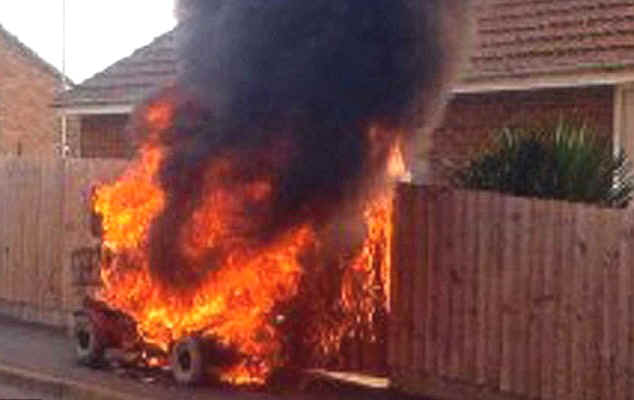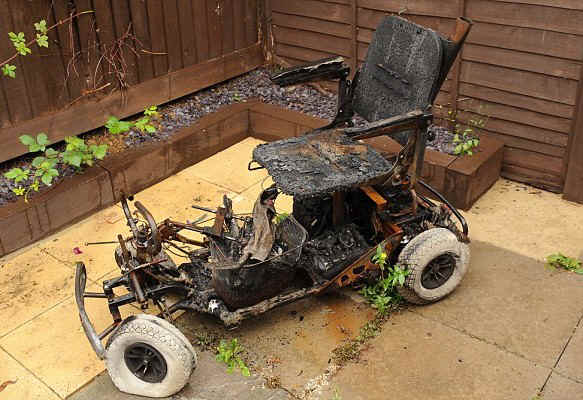

Sidmouth FolkWeek 2011 - Fire on the Bulverton campsite and near misses with scalding hot water.
Many folk festival campsites are an accident waiting to happen - if only because so often caravans, tents and motorhomes are parked too close to one another. Another factor is the often poor condition of both the caravans (for which no annual test is required) and their gas appliances.
On the Sidmouth Bulverton site the risks are exacerbated by parts of the site being difficult to access during wet weather.
In 2011, a small gas appliance caught alight on the Bulverton site because the owner had somehow not installed the gas cartridge properly. Flames leapt from the burners (maybe because liquid rather than vapour was being fed to the jets) and then the canister itself caught fire, causing flames to leap out. Having some presence of mind the (female) owner managed to turn the whole heater upside down. Water had no effect - as might be expected - and the fire was put out using a dry powder extinguisher from a neighbouring motorhome.
This involved only a small portable gas appliance. A fire involving a much larger gas cylinder could easily have spread to several adjoining units - many caravans have glass fibre panels and the resin burns well - as can be seen in these photos of a small mobility scooter that caught fire owing to an electrical fault. The partially disabled owner was dragged clear just in time. The newspaper article is here.
Cars also burn well once ignited and many have plastics fuel lines underneath - any grass fire spreading across land could result in several becoming fireballs - and in close proximity to trees and houses on Higher Woolbrook Park. It may never happen - but it might be sensible to avoid using parts of fields that may become inaccessible in wet weather (not that emergency vehicles could arrive in time to do very much) and to insist on a more regular spacing of tents and caravans, etc. Perhaps the two most dangerous features of caravan and car fires is the speed with which they can spread and the intensity of the fire. Tents are manufactured from 'flameproof' materials, but in close proximity to a burning vehicle, they would probably simply either melt or be vaporised.
 |
|
Another serious incident in 2011 occurred not on the campsite but in a local restaurant - a waiter was bringing two jugs of hot water (to refill teapots?) and as one was removed from the tray he was holding it became unbalanced and the second jug tipped all over a member of one of the display/dance teams.She suffered scalds to several parts of her body but was released from the local hospital after treatment - and spent the evening apparently in the Manor Pavilion. Friends arranged accommodation for the night.
A third incident could have left Colin Hume (a leading social dance caller) with serious injuries. He related the story to one of his early dance workshops. He explained he was in self-catering accommodation. There was no hot water and he needed to wash. He rummaged around in the airing cupboard and found the immersion heater switch and some sort of thermostat. In the morning, scalding hot water issued from the hot taps and so he tried the cold ones - they too produced hot water. After running the cold tap for ten minutes the water cooled down sufficiently for him to wash in it - so he made the joke that he had eventually managed to wash in hot water from the cold taps.
He was actually lucky - I told him after the workshop that I knew more about plumbing and electrical systems than I did about dancing. What probably happened was that the immersion heater thermostat had failed and this caused boiling water to overflow into the header cistern in the loft - which in turn fed the cold taps. In some cases where this has happened, the plastic cold water cistern (old types of which were not designed to withstand hot water) can 'flop' and split and this can empty 30 or 40 gallons of scalding water through the ceiling - and if you happen to be asleep beneath the cistern when the water and wet plasterboard descend you can be scalded to death. Two fatal incidents of this type led to the introduction of a new type of thermostat for domestic immersion heaters. Full details of this rare problem are here. An advisory note from the HSE has also been issued. Thermostats that feature a failsafe overtemperature cut-out cost about £7 and take 5 minutes to fit - there is usually no need to change the immersion heater itself as the new thermostat should fit in the original casing. For some reason, the older type are still sold!
One last point - if Colin Hume's accommodation was arranged by FolkWeek, was it properly inspected and with appropriate certificates? It may be that the electrical approvals that are required for rented property do not include checking whether immersion heater thermostats are the fail-safe type. If not, perhaps they should!